
back to Elongated Skulls from Ancient Races on Earth

|
This part deals with several physical features that are typical for elongated skulls, and that distinguishes them from normal human, Homo sapiens, skulls. I have included pictures to illustrate these features, and you can see many more pictures if you follow the links to the different continents on the Elongated Skulls from Ancient Races on Earth page. |
|
Contents of this page 1. The Difference Between Long and Round Skulls 2.3 The 'Missing' Sagittal Suture 5. The Origin of Elongated Skulls Text between square brackets [] and bold emphasis are mine. |
|
Not all elongated skulls are the same. There is a lot of variation in their shape and form. As most of the current attention is to the extreme long Paracas skulls in Peru, other skulls of smaller size are often forgotten. Nevertheless, the latter also show features that are different from normal human (round skulls) skulls. For the latter a significant contribution was made by the 19-20th century John Thurnam, a British archaeologist who studied the English long skulls. Although the Paracas skulls are important, and the initial studies are already quite revealing, I hope the same attention will also go out to the other long skulls found all over the world. |
|
1. The Difference Between Long and Round Skulls The most known long skulls are the extreme elongated skulls of Paracas, Peru. With those people it is obvious that these belong to a separate race of humans. For the other races of people with long skulls which were medium large, sometimes in the horizontal plane, sometimes the forehead was slanted upwards at an angle, the archaeologists of the 19th and early 20th century based themselves on the cephalic index to measure skulls, and to distinguish these long head races from normal humans. So it is important to understand what the cephalic index is, and the terms they used. The cephalic index, or cranial index, is the ratio of the maximum width of the head multiplied by 100 divided by its maximum length, in the horizontal plane, or front to back. |
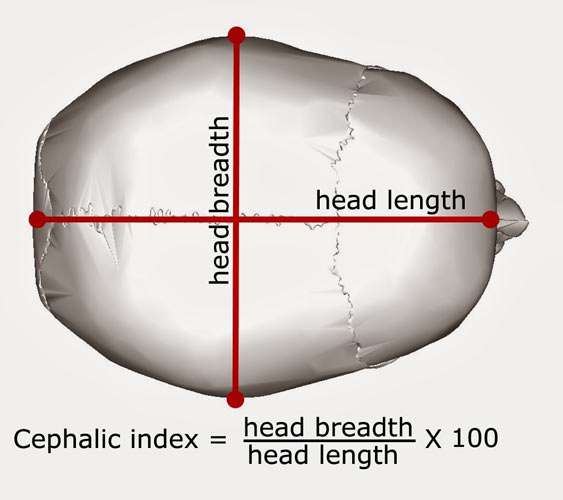
|
Round skulls, or brachycephalic skulls, are typical for what we know as present day humans, or Homo Sapiens. Their cephalic index is larger than 81-83, what means that the width of the face is slightly smaller than the length of the skull. In other words, they have a very round skull. When a skull has a cephalic index smaller than 71-73, its length, front to back, is a lot larger than with the round skulls. These skulls are called dolichocephalic skulls, or long head skulls, or elongated skulls. These skulls can be quite different and they were considered to belong to another human race. Mesocephalic skulls are those that are in between the round and long skulls, often ovoid in shape. They are the result of interbreeding of round skull and long skull people. When reading the following texts, keep in mind these terms. I will also use the term 'round skull people' when referring to Homo Sapiens, or what we now call modern man. |
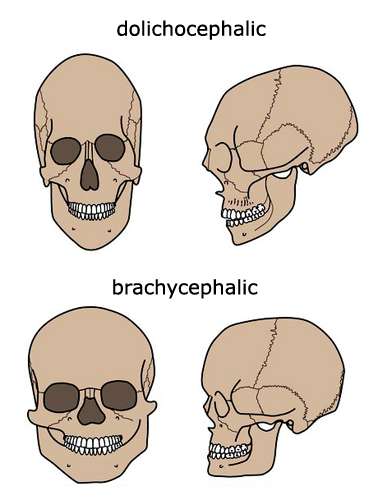
|
While we find extreme long skulls in in the Paracas region of South America, elsewhere in the world the elongation of the skull is not that extreme, but still can be quite larger and different in form than a normal round skull of Homo sapiens. John Thurnam, a prominent English archaeologist of the 19th century (1810-1973), excavated and examined the barrows in the Salisbury plain, South England. He was also a craniologist and studied the excavated round and long skulls of Southern England. He found a marked difference between the round and long skulls excavated from the narrows which must have had an effect on how the brain filled up that extra space: Turning to the hind head, we find the supra-occipital region full and rounded in the dolichocephalic Britons [round skulls], giving room for the backward development of the posterior lobes of the brain, which in this series must have materially overlapped the cerebellum; whilst in the other [the round skulls], the occipital tuberosity becomes the most prominent part, and the cerebellum can have been barely covered by the posterior lobes of the brain. As common in long skulls, those of the pre-Celtic Britons are more or less depressed—platycephalic; whilst there is a compensatory elevation in the brachycephalic series, or more or less of the form termed acrocephalic. (John Thurnam in On the two principal forms of Ancient British and Gaulish Skulls (1865), page 35) The last comment, the depressed or platycephalic feature, refers to a marked flatness on the top of the head. It seems that this was common to the long head people of England. This is evidenced in the picture of one of those skulls, from a woman found in the Tilshead Long Barrow, and photographed by British dowser Maria Wheatley (below left). We find the same depression on the elongated skull from Malta (below right). |
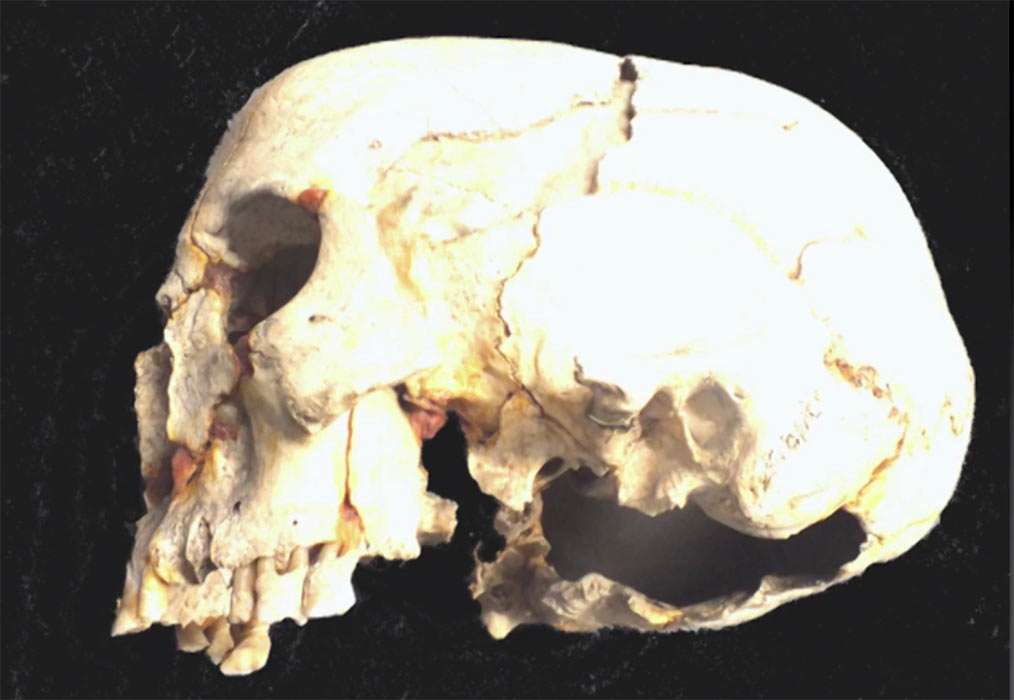 |
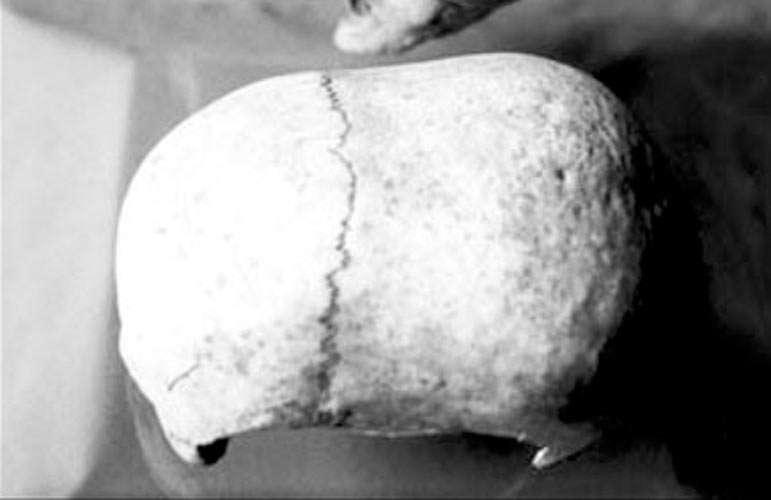 |
|
In Europe not all elongated skull were of this type. With some of the skulls the forehead extended upwards at an angle and then went backwards. Below are two examples. Also notice that the shape of the skull is different too. The left one has a bump at the upper end of the forehead, while the middle skull is nicely rounded all over. The right skull from Austria goes straight backwards but is pointed at the back of the head. It is obvious that there were several different types, or shapes, of elongated skulls present in Europe. |
 Germany |
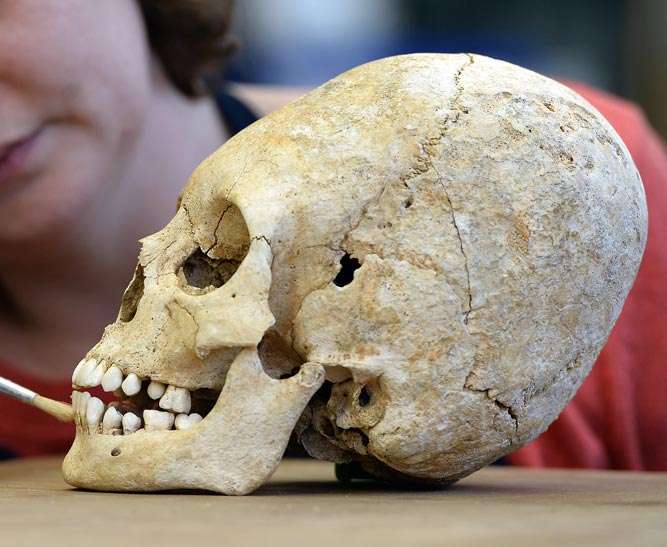 France |
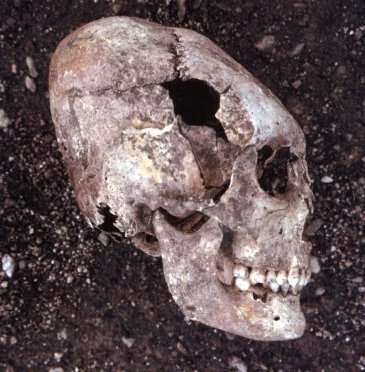 Austria |
|
The variance in the shapes of elongated skulls becomes even more obvious when looking ate the elongated skulls in Middle and South America, where many of them have been preserved and displayed in museums. The following two skulls extends straight upwards: |
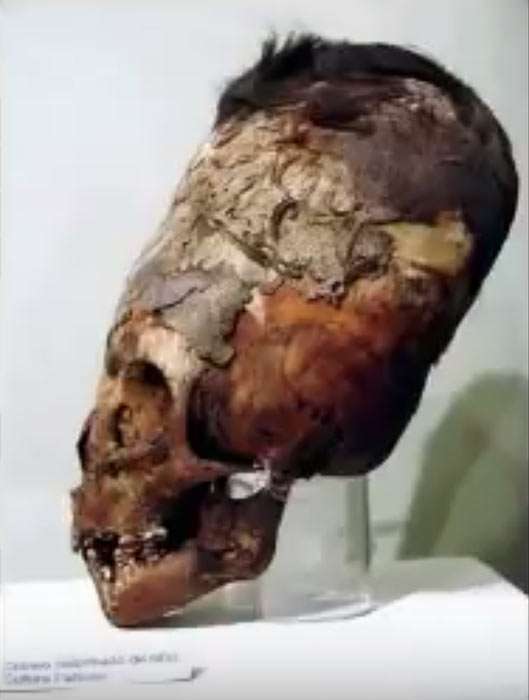 Forehead straight upwards with wide rounded top. |
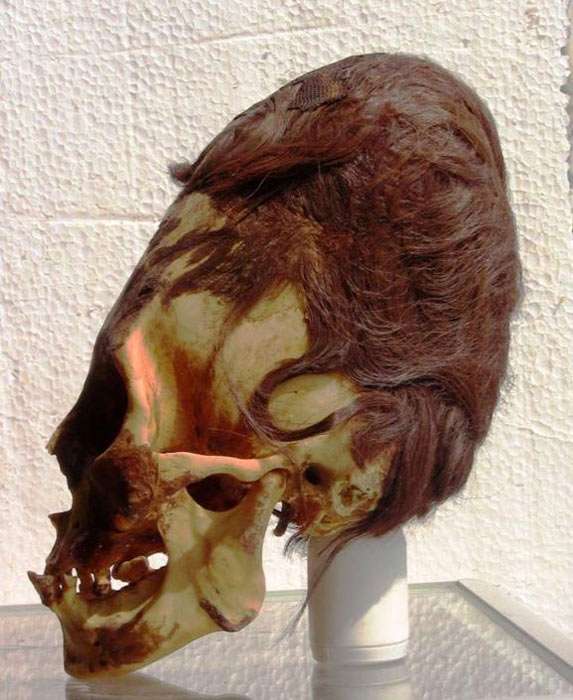 Forehead upwards with conical rounded top. |
|
Then we have the 'up and slanted' types: |
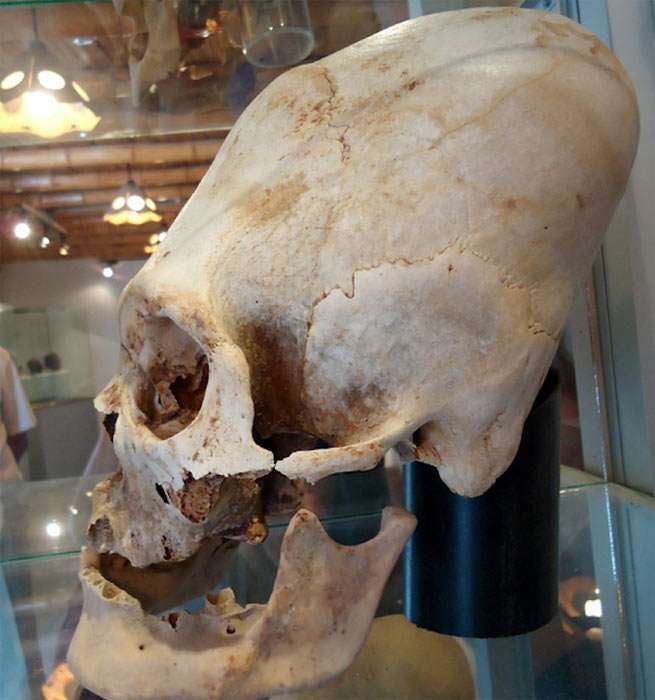 Forehead upwards and then slanted backwards. |
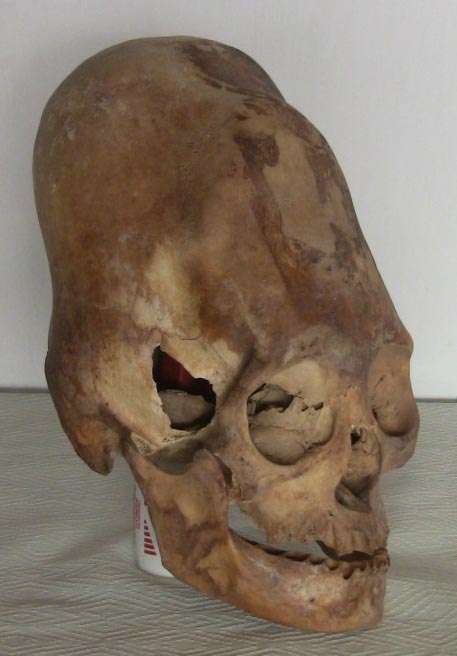 Ica skull. This one has an upwards elongated forehead, but the forehead itself is very strangely shaped with two parallel depressed areas, with a sharp ridge on the sides. |
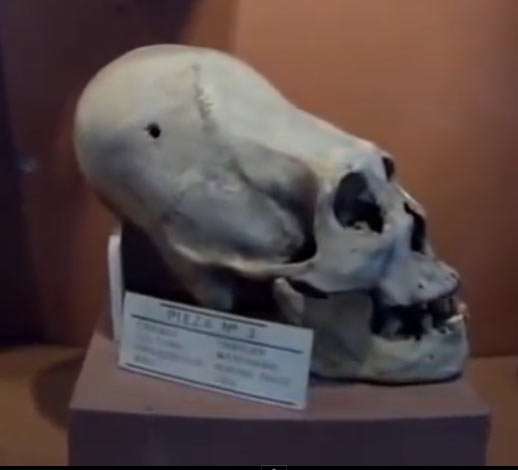 Bolivia skull. Although the forehead goes straight backwards, at the end it has a bulb appearance. |
|
Some of the skull have foreheads that go straight backwards: |
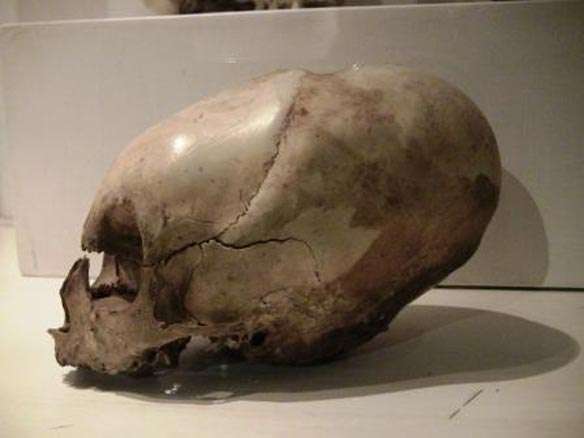 Cusco skull. The forehead goes almost straight backwards, and has a ridge or bump in the middle. These also appear in Europe. |
 Skull from Austria. |
|
It is obvious that there were many types and forms of elongated skulls in the world. The question is how did they all come into being. It is to be expected that there would a variance because of cross breeding between different races, but some of the extreme long skull still makes us wonder how they came about. The other question is about the brain mass which was larger than those of round skulls, or Homo sapiens. |
|
The volume of these elongated skulls is larger than that of a human skull, especially in the extreme long skulls of South America. Deforming a skull does not increase its volume. The cranial capacity of a human is between 1200 cc and 1850 cc with a maximum of 2000 cc (cc=cubic cm). The estimated cranial capacity of the elongated skulls of the Paracas region in Peru ranges between 2600 cc to 3200 cc. One wonders if the increased brain mass of these long head people also gave them additional or extended mental capabilities. In Europe however, the long skulls, are not that much longer or voluminous than a normal human skull, but they are still significant and have more volume. |
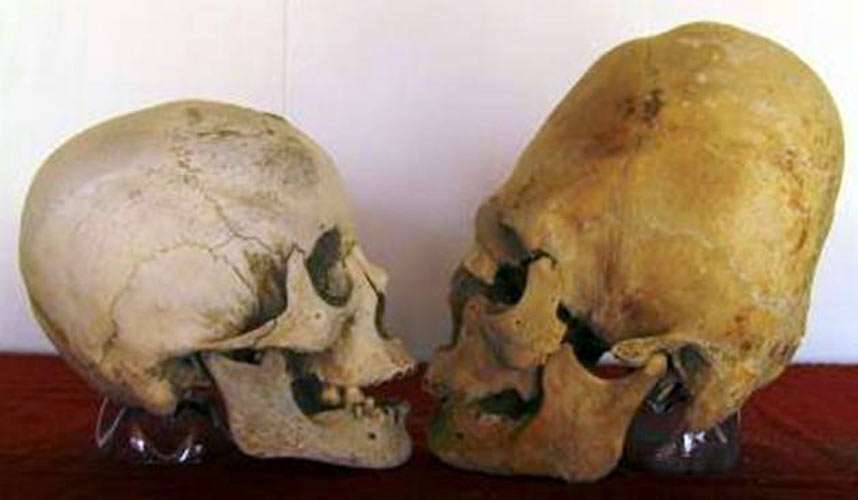
|
2.3 The 'Missing' Sagittal Suture Some people have stated that some of the elongated skulls did not a sagittal suture because the excavated skulls did not show one. This would imply that they were born with two instead of three skull plates. However there is an underlying process that should be taken into account. This is totally unique to the long skull races.
John Thurnam, the English archaeologist, who excavated and examined the barrows in the Salisbury plain, South England, was also a craniologist. With the elongated skulls (from the long barrows) he never mentioned a complete absence of the sagittal suture. In Thurnam's drawings of the elongated skulls, a sagittal suture is always present. However he noticed a very particular feature. In Further Researches and Observations on the Two Principal Forms of Ancient British Skulls, page31-35, Thurnam describes the various anatomical differences between the long skulls of the Ancient British people (which had long skulls) and the round skulls of the Gaulish people. In regard to the sagittal suture, on page 35, he says: "The dolichocephalous skulls [long skulls] from the long barrows differ, likewise, in a very curious respect, from those of the brachycephalous [round skulls] series; viz., in their greater liability to premature obliteration of the sutures. This can hardly be regarded as other than a race-character, which these skulls exhibit in common with those of other dolichocephalous peoples..." So, it is not that the long heads were missing the sagittal suture. The long head race had a tendency to fuse together the cranial plates at a much faster rate than was and is the case with the round heads. Sometimes it already happened when the long head person was in its infancy. "In the same class of skulls, the sagittal suture has, in several instances, been found more or less effaced,..." Thurnam surmises that the reason for early obliteration of the sagittal suture is an exuberant ossification [bone formation] produced by a diet high in meat, and also because the closer contact of the skull plates at the sagittal suture [with long skulls] by which ossification happens much earlier in life. So, the long heads are not missing the sagittal suture. It ossified very early in life, so it became hardly perceptible later on in life. It is definitely a very defining characteristic of the long heads, as we do not see this happen with round skulls. "No such effacement has been observed in the brachycephalous [round] skulls from the round barrows." |
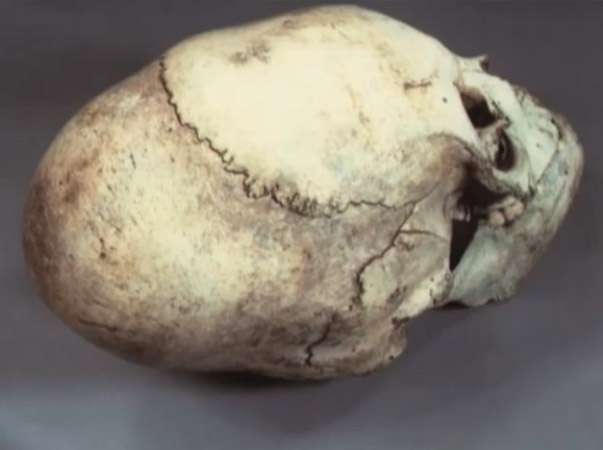 Skull from Puma Punka, Bolivia |
 The Malta skull in Europe also show the obliteration of the sagittal suture. |
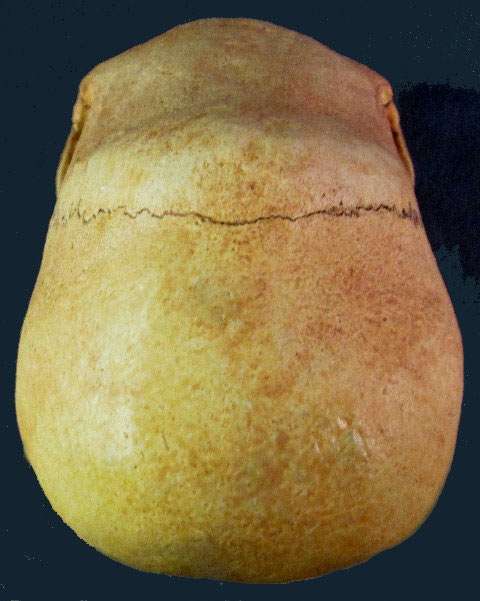 a Peru elongated skull |
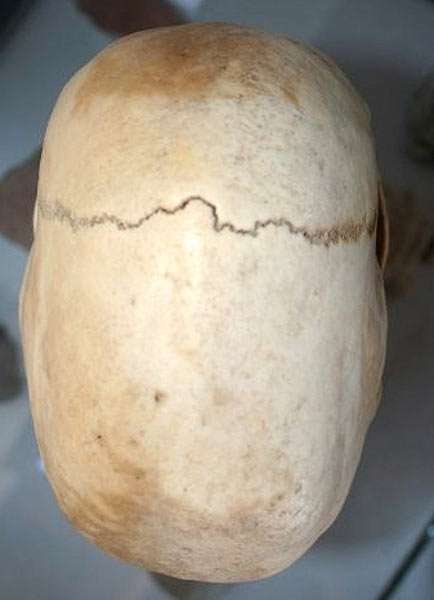 A Paracas skull from Peru with missing sagittal suture. |
|
I also found a curious reference to another feature of the sagittal suture associated with a long skull. On page 6 of On the two principal forms of Ancient British and Gaulish Skulls (1865), John Thurnam talks about the findings of another archaeologist, Mr. Bateman, who says about the elongated skulls found in the long barrows of the Dobunian district: "The interments within the chambers have been many, and apparently continued over some length of time. They are marked by a strongly-defined type of skull, the more obvious feature being excessive elongation and a laterally compressed appearance, enhanced sometimes by the sagittal suture being elevated into a ridge." The ridge feature was also found in a dolichocephalic skull in Scotland: "In the norma verticalis each skull had an elongated ovoid outline, though one was proportionately wider than the other, and the cephalic indices were respectively 75 and 72.8, dolichocephalic; the sagittal line was ridged, and the side walls were bulging,..." (Source: A contribution to the craniology of the people of Scotland. Pt. I. Anatomical. by Turner, Wm. (William), Sir, 1832-1916; Royal College of Surgeons of England, page 587) This source cites several dolichocephalic and hyperdolichocephalic skulls in Scotland. This sagittal ridge was also found in a contemporary find in Onavas, Mexico. See my page of South and Middle America (with picture). |
|
When examining the Paracas skulls from South America, both Brian Foerster and L.A. Marzulli discovered that the foramen magnum is in a different place than with a normal human skull. The foramen magnum is a large oval opening in the occipital bone (back and lower part of the skull) of the skull in humans and various other animals. The spinal cord passes through the foramen magnum as it exits the skull. |
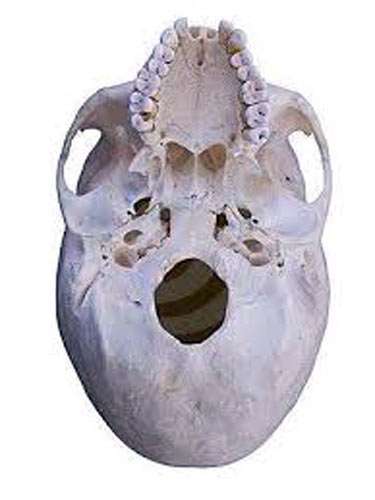 Foramen magnum at the bottom of a human skull |
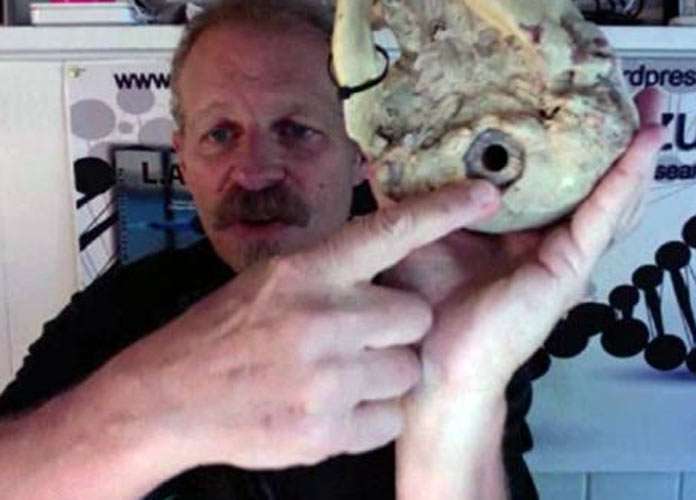 Marzulli pointing out that the foramen magnum on an elongated skull is situated a lot more towards the back of the skull than it is with a normal human skull. (from a YouTube video interview) |
|
Because the position of the foramen magnum is linked to the balance of the head in bipedal beings, it is to be expected that when a being has a very elongated skull, that the foramen magnum has to be in another place in order to balance the extra weight and angle of the long skull. Marzulli also states that the foramen magnum with the elongated skulls is smaller than with humans. At the same time it shows that these long skull people are not of the Homo sapiens race (that is, us, modern humans), or they are of a very modified human race. When looking through old archaeological records, I happened, by accident, find that this anomaly of the foraman magnum had already been observed by P. F. Bellamy in A brief Account of Two Peruvian Mummies in the Museum of the Devon and Cornwall Natural History Society, by By P. F. Bellamy, Surgeon, of Plymouth (in THE ANNALS AND MAGAZINE OF NATURAL HISTORY 5 INCLUDING ZOOLOGY, BOTANY, and GEOLOGY, Volume 10, 1842, London), page 98: "The position of the foramen magnum too is remarkable, for it will be found to be considerably anterior to the centre of gravity..." |
|
For so far as the hair of mummies has been studied, both the Paracas aristocracy and the Egyptian dynastic rulers had several members among them that had red hair. Both lived among people with dark hair. The Paracas Aristocracy The Paracas skulls are well preserved because of the dry climate and soil. Some of them still have their hair, which in every case is (naturally) red. That is interesting because recent DNA analysis of the Neanderthal genome have shown that Neanderthals had red hair. Did the Paracas people inherit their red hair color from cross breeding with Neanderthals in the distant past? |
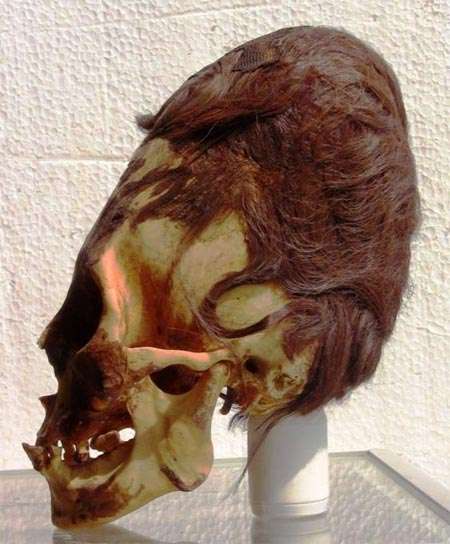 Skull from Peru, photo from Hidden Inca Tours |
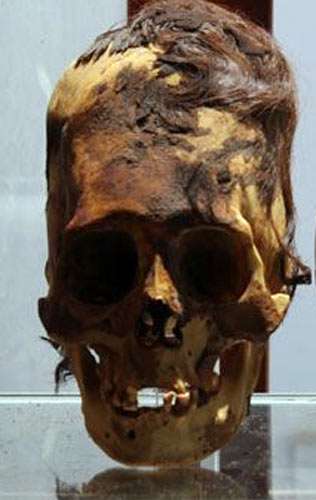 red hair skull from Peru |
|
Egypt's Dynastic Rulers We also find red hair with the long head rulers of Egypt. Queen Tiye, the mother of the famous Akhenaton had red hair. A lock of her hair was found in Tutankhamen's tomb and upon testing it turned to be auburn. Natural red hair was also discovered in association with a male mummy in Burial No. 79. Source: Mathilda's Anthropology Blog Ramses II's skull was dolichocephalic, or long headed, with an cephalic index of 74 as measured by Archibald Sayce (1845-1933) who was a British Assyriologist and linguist, but also worked in Egypt. And, Ramses II's hair was red. Professor P. F. Ceccaldi, with a research team behind him, studied some hairs which were removed from the mummy’s scalp. Rames II was 90 years-old when he died, and his hair had turned white. Ceccaldi determined that the reddish-yellow color of the mummy’s hair had been brought about by its being dyed with a dilute henna solution; it proved to be an example of the cosmetic attentions of the embalmers. However, traces of the hair’s original color (in youth), remain in the roots, even into advanced old age. Microscopic examinations proved that the hair roots contained traces of natural red pigments, and that therefore, during his youth, Rames II had been red-haired. It was concluded that these red pigments did not result from the hair somehow fading, or otherwise altering post-mortem, but did indeed represent Ramesses’ natural hair color. [L. Balout, C. Roubet and C. Desroches-Noblecourt, and was titled La Momie de Ramsès II: Contribution Scientifique à l’Égyptologie (1985), page 254-257.] Apparently, the Ramses lineage believed themselves to be divine descendants of the god Seth (who had red hair), with their red hair as proof of their lineage. So, they might have been descended from a long line of redheads. [Balout, et al. (1985) 388-391.] Dr. Joann Fletcher, a consultant to the British Bioanthropology Foundation, has proved that Seti I (the father of Rames II), had red hair. [Parks (2000).] It has also been demonstrated that the mummy of Pharaoh Siptah (a great-grandson of Rames II), has red hair. [Partridge (1994) 169.] Source: Kabylia Blog |
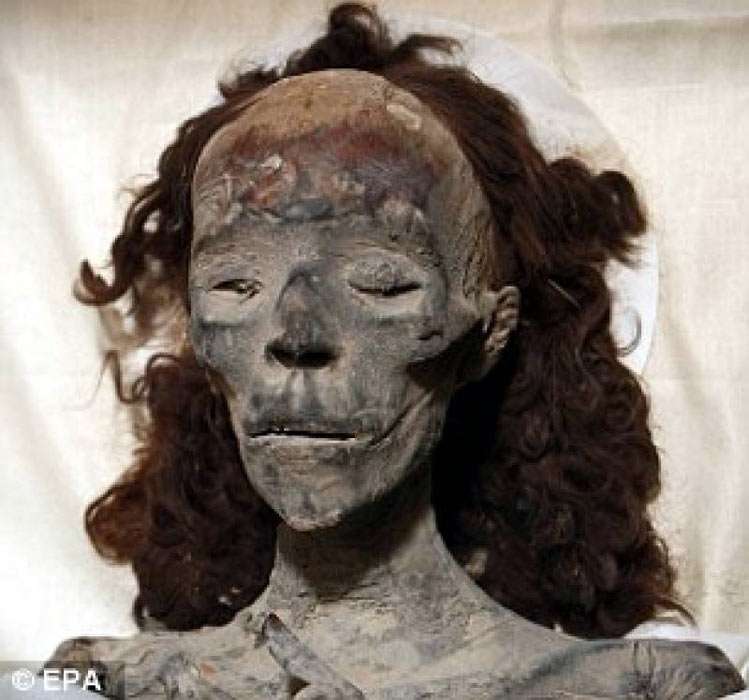 Queen Tiye with red hair; she also had a long skull. |
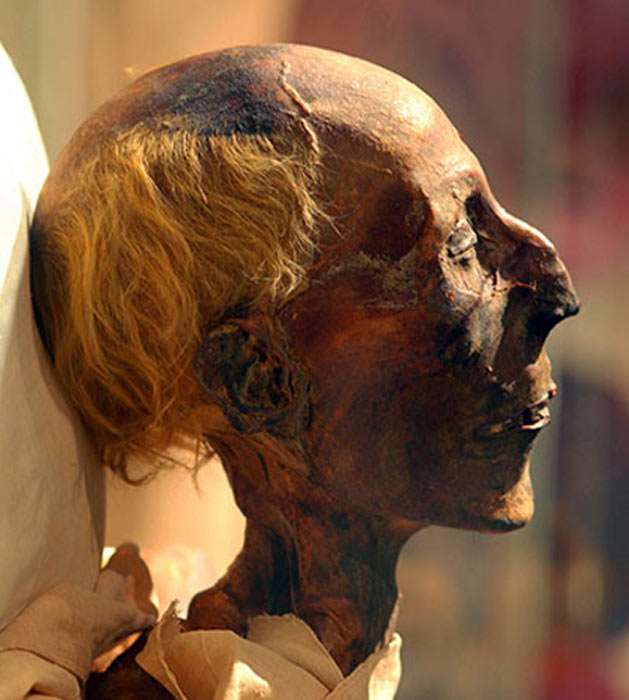 Ramses II: long head and red hair |
|
Some researchers have noticed that some elongated skulls have two holes on the back of the skulls, which are not present on normal human skulls. That is not correct. They appear in normal human skulls too. They are called 'parietal foramen'. They can be present in he developing fetus, but ossify quickly. Due to a genetic defect in some people, they do not ossify or close, and are thus open and present in adults. Brian Foerster of Hidden Inca Tours pointed out this feature, but does not seem to be familiar with the parietal foramen feature. Until this has been researched more in depth, we cannot see this as a different characteristic in regards to normal skulls. |
|
a Paracas skull with the two holes, photo from Hidden Inca Tours website |
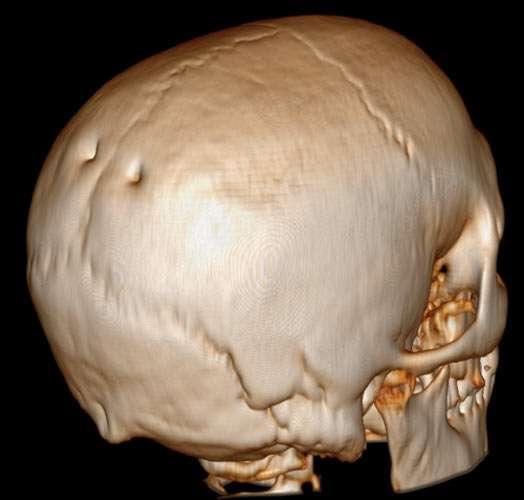 a normal human skull showing the two holes. |
|
From the larger size of the Paracas skulls, it has been deduced that these humans must have been seven to eight and a half foot tall. As most skulls have been separated from their skeletons (especially by illegal digs) their is not much information of how tall these beings really were. In Europe the long head people were rather small in stature: about 5 feet 5 inches (John Thurnam in On the two principal forms of Ancient British and Gaulish Skulls (1865), page 40-41). They did not have the extreme long skulls of the Paracas people. The length of the skull was less. |
|
Not much information is available on the teeth of long skull people. I have found only two examples of teeth anomalies: Below is a child's skull found at Lake Titicaca in Bolivia. The child was less than two years old because the fontanel had not yet closed, indicating an age of less than 2 years if this was a human child. Nevertheless this baby skull had 24 teeth. With humans, on a six year old child can have 24 teeth. |
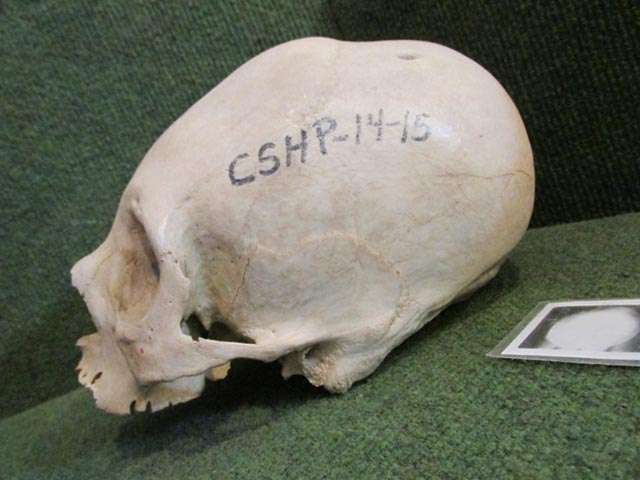
photo and info from Hidden Inca Tours
|
This is another baby found near Cusco, Peru, and at present in the Privado Ritos Andinos museum. Experts who examined the skull say that it was not artificial deformed. The baby was born with this elongated skull. It is about 18 months old, but it has teeth of an 7-12 year old. Its set of teeth was fully grown, but contained fewer molars than humans have. |
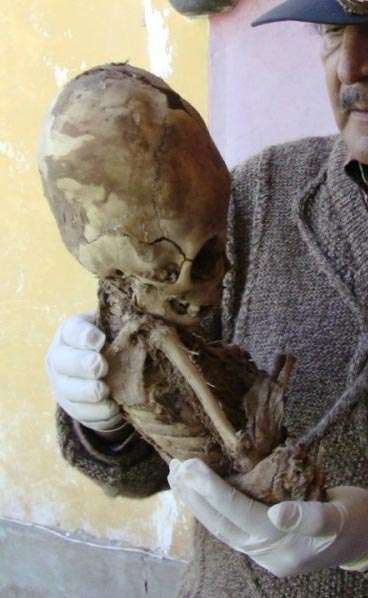
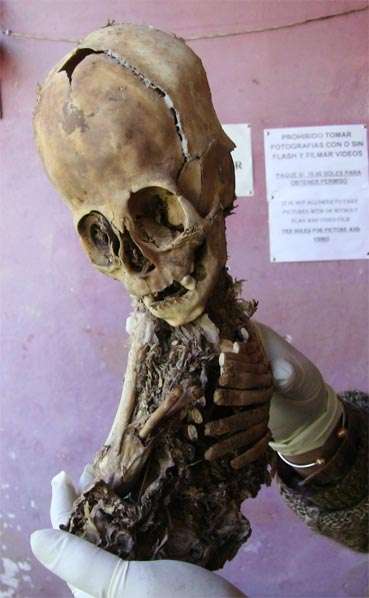

photos and info from Hidden Inca Tours
|
With humans, the nasal root is the top of the nose, forming an indentation at the suture where the nasal bones meet the frontal bone (the skull plate that forms the forehead). While some of the long skull people existed thousands of years ago, some of them were still around not so long ago. The Maya cultures in Meso-America left behind a lot of statues and clay figures, which show that many of their aristocratic members had not only elongated skulls but also long noses that start way up on their forehead. |

Ball player from the island of Jaina in Mexico
|
How do the experts, the archeologists, explain these long noses? I once went to a lecture by Anton Vollemaere, a Dutch anthropologist, who was famous for a major contribution to the deciphering of the Mayan hieroglyphs. I asked him about the long noses. Yes, he knew about it, but his explanation was that the aristocracy implanted a stone piece underneath the skin in order to elongate the nose for esthetic purposes. When I asked him if they had ever found these stone pieces with the skeletons, his answer was no... In my opinion it was a natural feature of those people. If they used these stone inserts, then they would
have been found with the skeleton remains, wouldn't they? Furthermore, The
skin is very tight above the nose. They would have to cut open the skin
in a straight line, place a stone piece in it and try to pull the skin over
it, and sew it back together. I think it is not possible, besides being
painful, even if you want to insert the stone piece through a small cut,
and shuffle it upwards. Also, the area of the bridge of the nose is irregular,
so try to cut a piece that will fall smoothly in place with the rise and
fall of the nose, bridge of the nose and forehead, and make the line of
the 'artificial nose' straight. Besides all that, you will have a good scar
remaining too. It looks like these long noses beginning in the middle of the forehead were a natural feature. How that came about is again speculation, but probably it was another genetic mutation, or the result of genetic manipulation. A selection of figures with these particular long noses starting way up on the forehead: |
From Palenque, Mexico:
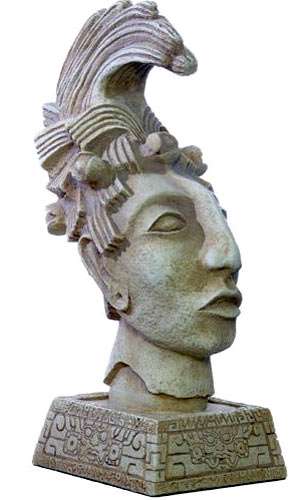 The ruler Pacal, Palenque, Mexico |
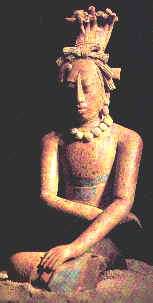 Palenque, Mexico |
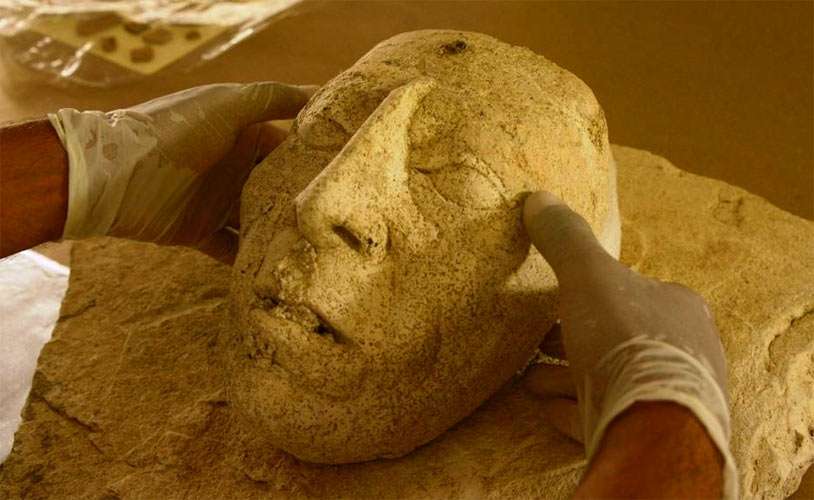 Mask of Pacal found in 2018 in House E at Palenque. |
|
Jaina, a small limestone island on the Yucatán Peninsula's Gulf coast with only a tidal inlet separating it from the mainland, seemed to have served as an elite Maya burial site, and is notable for the high number of excavated figurines. Many have long extended noses: |
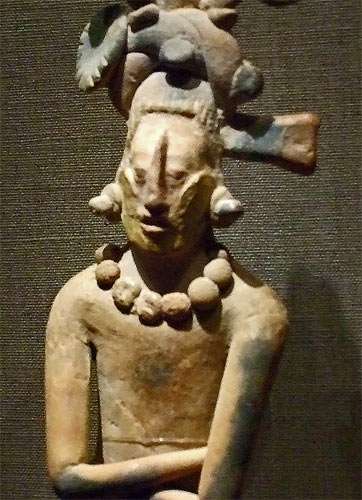 Jaina dignitary |
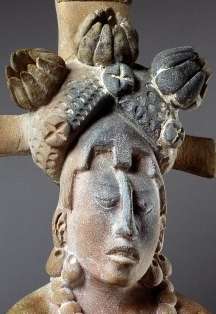 Jaina statue |
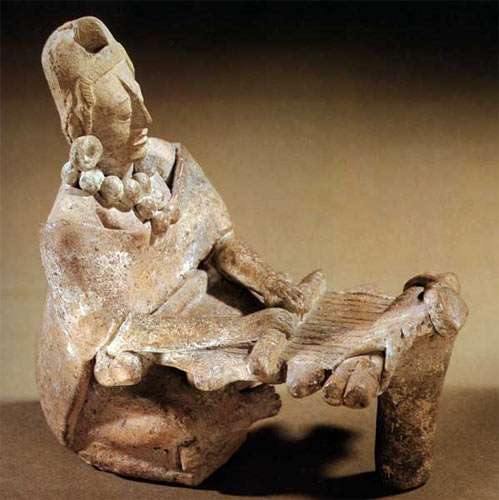 Jaina weaver |
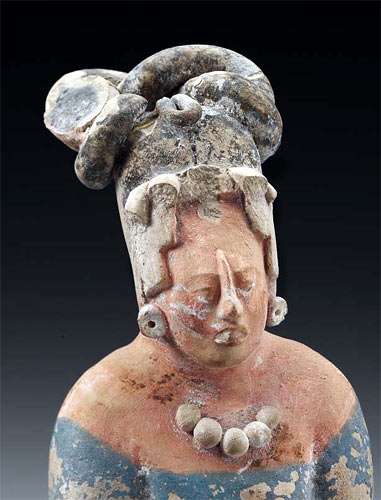 Jaina woman |
|
As of February 2014, Brien Foerster from the Hidden Inca Tours, released some preliminary result of DNA testing of the elongated skulls from the Paracas skulls in Peru: "We were permitted to take samples from five of more than 40 elongated skulls which are held by the local "Paracas History Museum". The samples consisted of hair (including roots), a tooth, skull bone and skin, while this process was carefully documented with photos and on video. With the help of the late Starchild researcher and founder of the "Starchild Project". Lloyd Pyle, samples were send to a geneticist in Texas for the procedure of DNA analysis." The geneticist’s findings: It had mtDNA (mitochondrial DNA) with mutations unknown in any human, primate, or animal known so far. But a few fragments I was able to sequence from this sample indicate that if these mutations will hold we are dealing with a new human-like creature, very distant from Homo sapiens, Neanderthals and Denisovans. The implications are of cause huge. “I am not sure it will even fit into the known evolutionary tree,” the geneticist wrote. He added that if the Paracas individuals were so biologically different, they would not have been able to interbreed with humans." If you are interested in the details of his ongoing DNA analysis of the Peruvian elongated skulls, visit Brian Foerster's very interesting Hidden Inca Tours website. Brian Foerster explains that they did repeated test on a skull from a two year old baby (2000 years old) wrapped in in several layers of textile. The test showed that the haplogroup came from Northern Europe. The second skull tested was 800 years old, and this DNA came from Syria, or the Mesopotamia area. (haplogroups in DNA are used to define genetic populations.)
The Paracas child (right) compared with normal human child of the same age. Needless to say how very different the skull itself is! They also found maternal DNA found from hair of another skull of which the DNA is "commonly found in Western Europe, especially among the Basque (27.8%) but also in Iberia and perhaps north Africa." So far, in regards to the Paracas people in Peru, we are looking at human species, separate from Homo sapiens, which ancestry came from Europe. That is interesting because the Paracas people had red hair, and the other species that had red hair were the Neanderthals which lived primarily in Europe and the Middle East. L.A. Marzulli states that the DNA results fit with his hypothesis that the Paracas people are the Nephilim. The Nephilim, according to ancient Biblical texts, are the offspring of the Fallen Angels and the women of earth, resulting in a hybrid entity, and they said to be based in the area of the Levant, the same place that the Paracas DNA traces to. The Fallen Angels are then extraterrestrials who came down in that area of the Earth to genetically tinker with humans, and create this new race. He says that the humans got fed up with this new, strange looking race, and decided to wipe them out, resulting in an exodus of the long skull people, in ships, to the Americas. (YouTube Interview with Marzulli) |

National Museum, Copenhagen. Left and middle skulls are elongated and trepanned.
|
It is also noteworthy that all over the world trepanation was a common practice among people with both round and elongated skulls. Why would this be? Maybe because their unusual head shapes were causing problems for their brains. Trepanation is usually done to release pressure underneath the skull. Some skulls have multiple trepanned holes, some of them even very large holes. Trepanation is not something you do for fun, there has to be a serious reason for such an operation. Some people have suggested that trepanation was done to enhance certain psychic abilities. When you look at the holes, it is clear that these were made by cutting with stone, or maybe metal, knives. A rather crude process. So, I think that it was done rather as a last resort to some serious medical issue. Two more examples: |
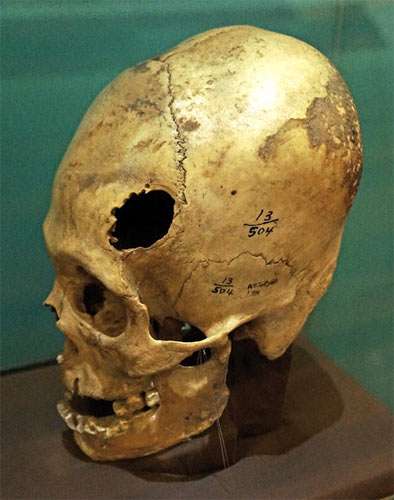 Paracas skull, from National Museum of Archaeology, Anthropology and History, Peru |
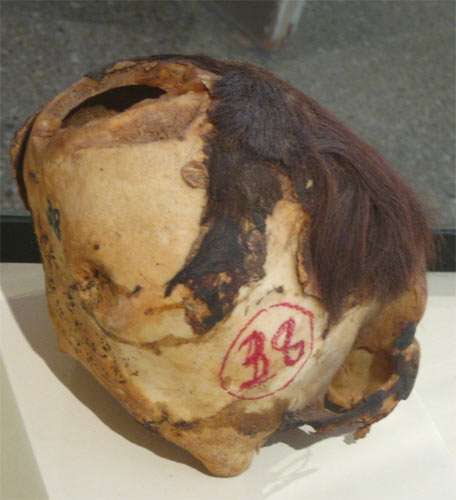 skull from Ica, Peru, from Museo Regional de Ica |
|
5. The Origin of Elongated Skulls Mesopotamia? We saw that Marzulli is of the opinion that the Paracas people not only came from the Middle east, as evidenced by DNA analysis, but that they were created there by genetic engineering by extraterrestrials. That might be hard to swallow by some most people, but a genetic intervention explains a lot. if there was only a random genetic mutation in an individual producing a long head, then his descendants would most likely have the same long head. What we see however is that there are many different types and shapes of long heads. That points more to an ongoing genetic tinkering by someone, trying this and that until they got what they wanted, if they ever did. I also wonder why they were doing this; what were they trying to achieve with a new human race gifted with long heads, and thus more brain mass? The Middle East always have been in the spotlight of those who believe in the extraterrestrial intervention in that place. It is the region where there was a sudden uprising of advanced culture, and legends of gods who came down to bring humanity all kinds of gifts, like agriculture and writing. Mesopotamia is considered the cradle of civilization for the Western world. Mesopotamia the area of the Tigris–Euphrates river system. In modern days it roughly corresponds to most of Iraq plus Kuwait, and the eastern parts of Syria. Mesopotamia has a very long history, but the height of the Sumerian civilization is around 5000 to 3000 B.C. It is during the Sumerian civilization that the so-called extraterrestrial intervention is supposed to have taken place. This period also corresponds to the long head skull people in England and continental Europe. It well established by DNA research that the European people migrated from the Middle East. So it is possible that something happened around or before that period in the Middle East that resulted in the emergence of long skulls? If the extreme long skulls emerged in Mesopotamia, a couple of thousand years ago, we would expect to have found some of their remains in that region. So far no extreme long skull have been found, although a few long skulls have been excavated in nearby countries. (click on pictures to go the Elongated Skulls Asia page) They are pretty long but not nearly what we find in Paracas, although some of the Paracas people also had the less longer skull type. |
in Lebanon: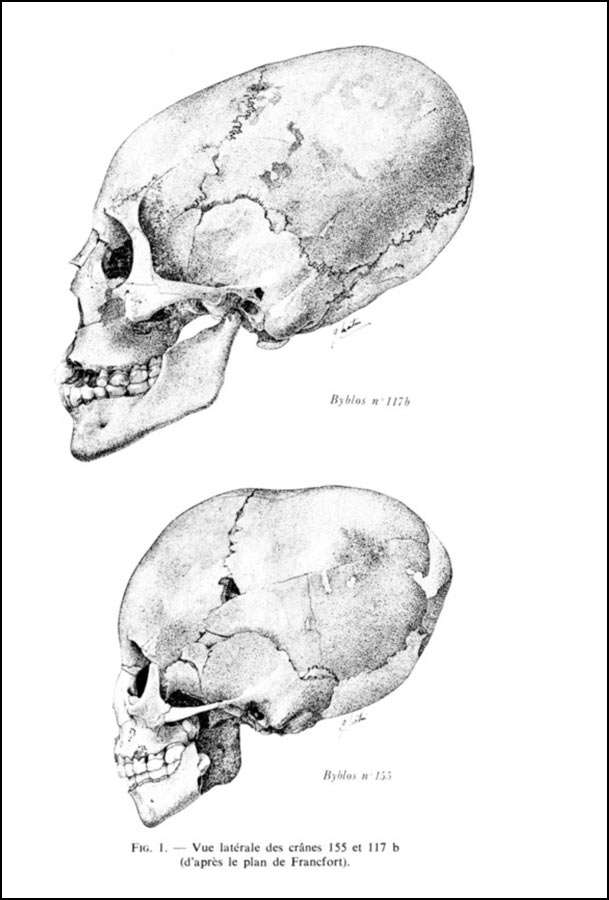 |
in Turkey: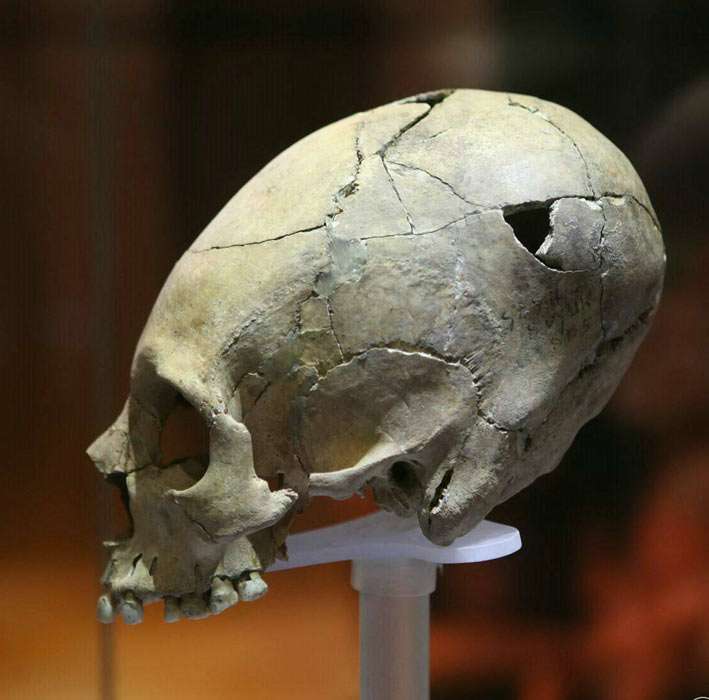 |
|
I looked around to find some statues that would depict long skulls. I managed to find only two: |
 Officially called Sitting God from Qatna (now Tell Mishrife, Syria). Bronze, Middle Bronze Age (ca. 1600 BC) |
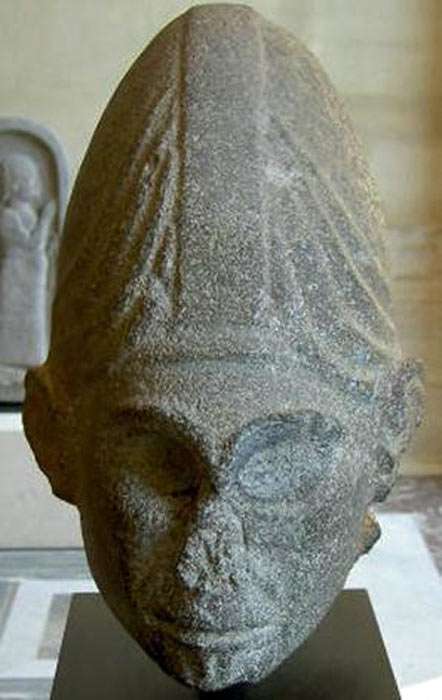
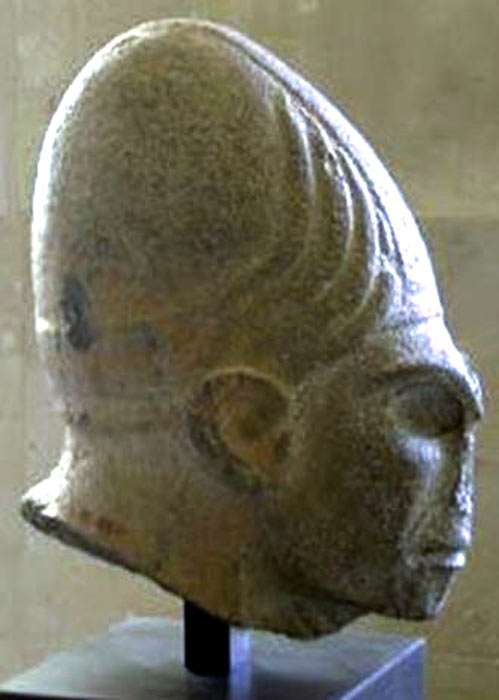 Life-sized head, carved in basalt, was found in the region of Lake Jabbul, east of Aleppo, Syria in 1926. |
|
That is not much to go on if one wants to point the Middle East as the origin for the extreme long skulls of the Paracas people, despite the fact that they have a Middle eastern haploid group in their DNA. It is also possible that the long skull Middle Eastern people migrated to the Americas, and that the extreme long feature happened over there. We do have a family of very long skulls appearing in Egypt: Akhenaton and his wife Nefertiti, and their daughters, and Tutankhamen who was or a son or grandson of Akhenaton and a human woman. They lived in the century of 1300 B.C. In regards to the other types of less long skulls in Europe, Asia and North America, these people seem to have been widespread, and migrated throughout the continents. So far it seems that the long head Neolithic people migrated east and west from the Middle East. But where the long head Middle Eastern people came from is still an open question. |
|
Still present not that long ago The Paracas people are thought to have flourish between 800BC and 100 BC, at least according to official estimates. If their European origin holds true with further DNA tests then the first settlers of this race might go back even further in time. Long skull people in South America have survived much longer than the former estimate. A team of archaeologists from universities in Poland, Peru and Colombia have discovered 150 mummies in the Atacama Desert belonging to an unknown culture that predates the Tiwanaku and Inca civilization by almost 500 years. (The Tiwanaku civilization is believed to have existed between 500AD and 1,000 AD, covering much of what is Peru and Chile today.) The bodies were mummified naturally by being buried directly in the sand with no stone structures, wrapped in cotton veils, reed mats or fishing nets, and radiocarbon dating shows that the oldest mummies came from 4th century AD, while the youngest mummies came from 7th century AD. Some of them had elongated skulls (they are of South America page) Brian Foerster radiocarbon dated a skull that proved to be only 800 years old. In Europe some elongated skulls were still around several centuries ago in the Basque region of Spain. See Elongated Skulls in Europe. |